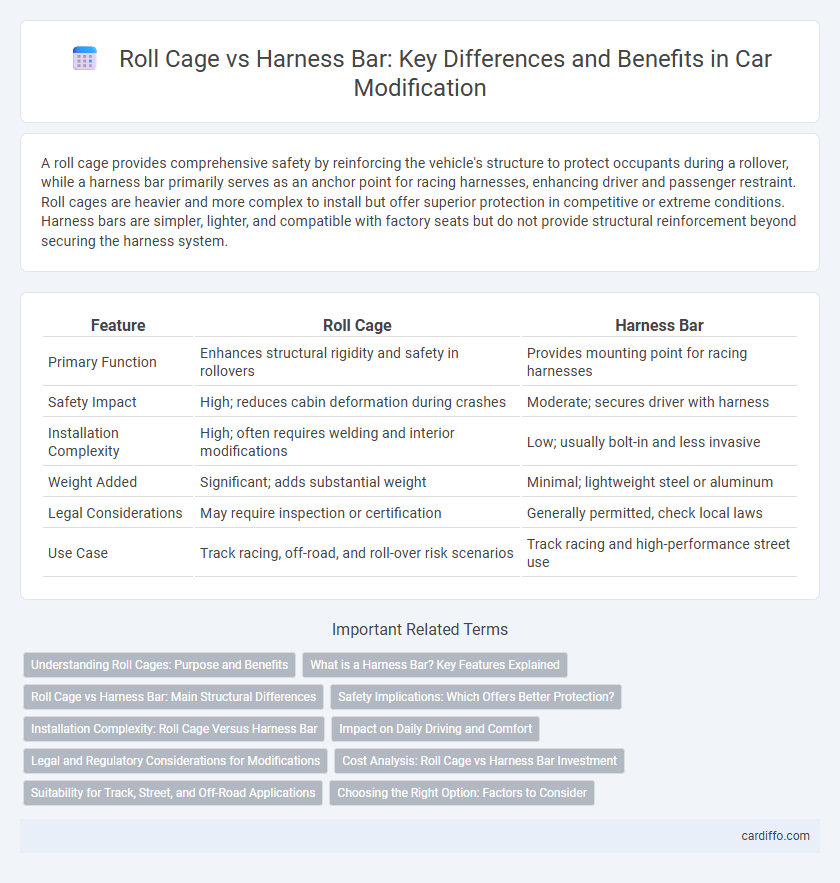A roll cage provides comprehensive safety by reinforcing the vehicle's structure to protect occupants during a rollover, while a harness bar primarily serves as an anchor point for racing harnesses, enhancing driver and passenger restraint. Roll cages are heavier and more complex to install but offer superior protection in competitive or extreme conditions. Harness bars are simpler, lighter, and compatible with factory seats but do not provide structural reinforcement beyond securing the harness system.
Table of Comparison
| Feature | Roll Cage | Harness Bar |
|---|---|---|
| Primary Function | Enhances structural rigidity and safety in rollovers | Provides mounting point for racing harnesses |
| Safety Impact | High; reduces cabin deformation during crashes | Moderate; secures driver with harness |
| Installation Complexity | High; often requires welding and interior modifications | Low; usually bolt-in and less invasive |
| Weight Added | Significant; adds substantial weight | Minimal; lightweight steel or aluminum |
| Legal Considerations | May require inspection or certification | Generally permitted, check local laws |
| Use Case | Track racing, off-road, and roll-over risk scenarios | Track racing and high-performance street use |
Understanding Roll Cages: Purpose and Benefits
Roll cages provide critical structural reinforcement by enhancing vehicle chassis rigidity, significantly improving occupant safety during high-impact collisions or rollovers. Designed with high-strength steel tubing, they effectively distribute crash forces and reduce deformation, minimizing injury risk. Unlike harness bars, which primarily serve as anchor points for racing harnesses, roll cages offer comprehensive protection by combining safety and performance benefits in motorsport or off-road applications.
What is a Harness Bar? Key Features Explained
A harness bar is a reinforced steel bar installed behind the front seats of a vehicle to provide a secure mounting point for racing harnesses, improving safety during high-performance driving. Unlike a roll cage, which offers comprehensive chassis reinforcement and occupant protection, the harness bar primarily serves to properly position and stabilize racing harness belts, preventing excessive movement. Key features include its easy installation, compatibility with various harness types, and ability to enhance driver restraint without significantly affecting cabin space.
Roll Cage vs Harness Bar: Main Structural Differences
A roll cage is a comprehensive safety frame designed to protect occupants by reinforcing the entire cabin structure, while a harness bar is a single crossbar installed primarily to support racing harnesses. Unlike a harness bar, which offers minimal impact protection, a roll cage significantly enhances chassis rigidity and crash resistance. The roll cage integrates multiple bars strategically placed around the driver's compartment, whereas a harness bar is limited to securing harness mounting points.
Safety Implications: Which Offers Better Protection?
A roll cage provides superior protection by reinforcing the vehicle's structural integrity, minimizing cabin deformation during a rollover or collision. Harness bars primarily serve as attachment points for racing harnesses, ensuring proper restraint but offering limited impact resistance compared to roll cages. For optimal safety in motorsport or high-risk driving conditions, a roll cage is essential, while harness bars complement restraint systems without significantly enhancing crash protection.
Installation Complexity: Roll Cage Versus Harness Bar
Installing a roll cage involves significant modifications to the vehicle's chassis, requiring welding and precise alignment to ensure structural integrity and safety compliance. A harness bar, by contrast, is comparatively easier to install, often bolting directly to existing mounting points without extensive vehicle alteration. The roll cage demands professional expertise and more time for installation, while the harness bar offers a simpler, quicker upgrade suitable for most street and track applications.
Impact on Daily Driving and Comfort
A roll cage significantly enhances vehicle safety but can reduce daily driving comfort due to added weight and interior space restrictions, causing less cabin noise insulation and harder entry and exit. In contrast, a harness bar offers improved harness mounting without major compromises to comfort or interior space, allowing easier daily use and maintaining the original cabin environment. Choosing between the two depends on balancing safety needs with everyday drivability priorities.
Legal and Regulatory Considerations for Modifications
Roll cages and harness bars both enhance safety but must comply with specific legal and regulatory standards, which vary by region and motorsport governing bodies. Roll cages often require certification and inspection to meet crash safety regulations, while harness bars need proper installation to maintain vehicle integrity and occupant protection under these laws. Failure to adhere to these requirements can result in penalties, voided insurance, or disqualification from competitive events.
Cost Analysis: Roll Cage vs Harness Bar Investment
Roll cages typically require a higher initial investment, ranging from $500 to $2,500 depending on material quality and complexity, whereas harness bars generally cost between $100 and $300. Installation costs for roll cages can also be significant due to the need for professional welding and structural integration, while harness bars are often simpler to install, reducing labor expenses. When evaluating overall value, roll cages offer enhanced safety benefits for track use, potentially justifying the higher cost compared to the more budget-friendly harness bar designed mainly for accommodating racing harnesses.
Suitability for Track, Street, and Off-Road Applications
A roll cage offers superior structural rigidity and comprehensive protection, making it ideal for track and off-road applications where safety and chassis stiffness are critical. Harness bars provide a simpler, lighter solution primarily suited for street use, allowing secure seatbelt harness installation without extensive modifications. Choosing between the two depends on the level of protection needed and the intended driving environment, with roll cages preferred for aggressive motorsports and harness bars for everyday street driving.
Choosing the Right Option: Factors to Consider
When choosing between a roll cage and a harness bar for vehicle safety modifications, prioritize the intended use, such as track racing versus street driving. Consider factors like installation complexity, structural reinforcement, and compliance with safety regulations specific to your motorsport discipline. The roll cage provides comprehensive protection against rollovers, while a harness bar mainly supports harness installation and improved seatbelt function.
roll cage vs harness bar Infographic

 cardiffo.com
cardiffo.com